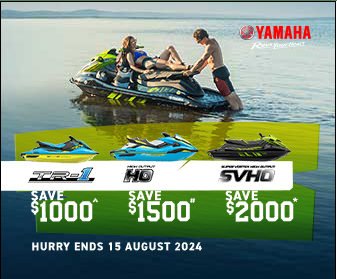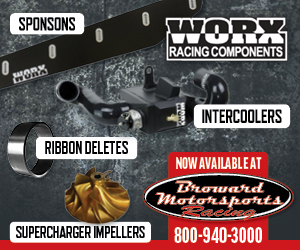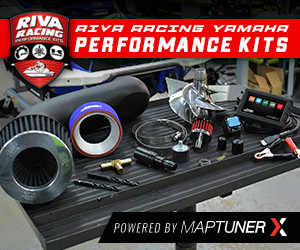The Watercraft Journal provides novice and veteran riders alike with a multitude of resources to help them navigate the difficult and often confusing process of selecting and purchasing a new personal watercraft. In this article we cover the fundamental steps each buyer should take when researching, selecting, and ultimately purchasing a new PWC from a dealership.
Self-Evaluation
Riders must ask themselves four core questions: Where am I going to ride, how am I going to ride, what is my experience level, and what is my budget? This should be the first step prospective buyers take when finally making the decision to purchase a new PWC.
1. Where am I going to Ride?
Are you planning to ride on a small private freshwater lake or in the Atlantic Ocean? Where you plan to ride will heavily influence both the type and brand of PWC you consider.
The Kawasaki Ultra 310, for example provides a proven platform for offshore conditions, the Yamaha GP1800 SVHO offers exceptional closed-course handling, and the Sea-Doo ST3 platform delivers a stable platform for fishing and cruising inland waters.
2. How am I going to Ride
Are you planning to ride one-up or will you be bringing your wife and child with you on your new ski? Do you want a sit-down runabout or a sporty stand-up? Do you want to go fast, or are you OK with cruising around at 35mph?
Will you be zipping around a fresh-water buoy course or cruising from Miami to Bimini? These considerations are all critical in ensuring you chose a ski that perfectly suits your needs.
3. What is my experience level
Have you owned a PWC or boat before, or is this your foray into the world of life on the water? Do you know the key differences between supercharged and naturally aspirated skis? Often time, first-time buyers will bite off more than they can chew with a PWC purchase.
The Kawasaki Ultra 310, for example, requires a variety of special maintenance- will you be doing this work yourself, or will you be relying on your dealer or mechanic to do it for you? Can you handle a 300-horsepower supercharged RXPX or would you be more comfortable on a naturally aspirated Sea-Doo GTI 130 SE?
4. What can I afford?
Conduct a realistic evaluation of your finances that include both your willingness and ability to obtain financing, either at a dealership or local bank/credit union.
Decide whether or not you can afford a base-model Sea-Doo spark on a galvanized trailer or a Yamaha FX SVHO Limited on a torsion-axle aluminum trailer, for example. Be prepared to look at models within your budget.
Information Gathering
1. What brand do I want to buy?
After conducting a self-evaluation, it’s time narrow down your search for a new PWC. You’ve watched The Watercraft Journal YouTube channel, and read through the hundreds of articles covering major offerings from all three major brands. Understand the pros and cons of each brand and the key differences between them.
All three brands offer different and often contrasting design features and characteristics that might perfectly suit one buyer while deterring another. Start with each brand’s website to explore key features and benefits on the latest models.
2. Social Media
Social media is often rife with falsified, biased, or incorrect information, so tread lightly when weeding through this type of material. Are you looking at a real-life owner review, or content from a paid brand ambassador?
Are you reading about complaints on a public forum where anyone can post, or are you reading about critical safety issues reported to the US Coast Guard?
Social media will give you a glimpse into both the good and bad of each brand and model, while also giving you an idea of what major issues or concerns others have brought up in the past.
3. Put your hands on different PWCs at a dealership or boat show
Check with local dealers to see if they have the models you are interested in on the showroom floor. Sit on each ski, knock on the hulls, take a look at the engine, open every compartment and make a detailed in-person assessment of the fit-and-finish of the models that interest you. Is it comfortable? Do you like the layout of the controls? Does the front storage fit your helmet with a top-mounted GoPro that you insist on wearing?
If your dealer doesn’t have any stock, try visiting a local boat show. Boat shows are a great way to experience many skis at the same time, with little pressure from salespeople. PWC clubs, rental outfits, test-drive events, and visits to the local sandbar are other ways you can get your hands on a PWC in-person before placing an order.
Ordering with Exactness
1. Be an informed buyer; “Be a Karen”
An informed and educated buyer will know exactly what they are planning to buy when they walk into that dealership. Buyers should know the product better than the salesman, and should be well informed about which accessories are included with each ski, and which must be purchased as add-ons.
2. Do NOT order online
You are not placing an order for a pair of socks from Amazon so don’t treat your PWC purchase this way! You always want to deal directly with a person- ideally someone who is positioned to negotiate with you and answer any questions you might have about the dealership, product, or additional add-ons like extended warranties or service plans.
3. Compromise is key
You have decided on a Yamaha FX SVHO Cruiser, but the dealer has told you it will be 6-12 months before your ski will arrive. They have a FX SVHO Limited on the lot right now, ready to go but it’s the wrong color and exceeds your budget. Often times, buyers are forced to compromise- settling for something other than what they initially wanted. This is the hard reality that you must accept sometimes if you want to walk out of that dealership with a shiny new ski.
Full Inspection
1. Don’t take delivery just yet
You’ve wheeled-and-dealed and now are ready to sign on the dotted line but wait! Before entering that dreaded finance office, make sure you have ample time to give your new ski an entire one-over from stem to stern.
Open every compartment, check each latch, get underneath the ski and check for scratches, cracks, or other damage. Check the engine compartment for signs of leaking fluids or broken parts. If anything looks awry, voice your concern immediately.
2. Right of Refusal
If the ski has a major defect or issue do not take it home! If your inspection reveals a major issue with the ski, get your dealer to correct the issue BEFORE you complete your purchase.
Failure to act on a major issue at time of purchase may mean you are stuck paying for a ski that now requires warranty work- meaning you could be waiting weeks or even months for parts. Cosmetic issues may never look right, even after dealers attempt to repair them under warranty.
If you have any reservations about the condition of your new ski, make these concerns known before completing the purchase. If you fail to thoroughly inspect your new ski and discover an issue only once you get it home, it will be much more difficult and frustrating to address than if you would have made this discovery before taking delivery.
Congratulations! You have competed your self-evaluation, done your research, selected the make and model you want, negotiated a deal within your budget, completed a full inspection, and are now ready to take your new PWC home! Just as if you purchased a new car or truck, make a call to your insurance agent of choice, and secure a PWC policy on that new watercraft.
Remember that factory warranties do not cover damage as the result of theft, collision, or negligence. And don’t forget to stay up-to-date with the latest PWC news and trends with The Watercraft Journal!









